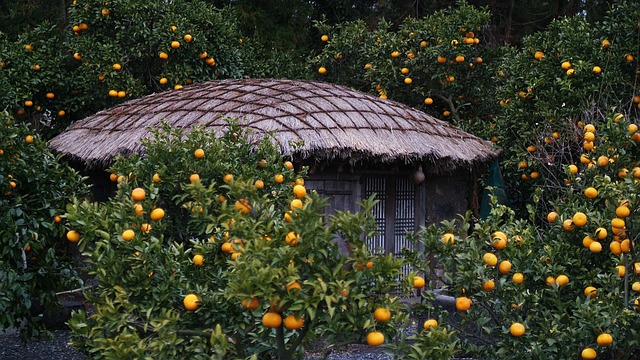Water-efficient irrigation systems are a cornerstone of sustainable garden design, offering precise, controlled watering that minimizes waste and promotes plant health. Technologies like drip irrigation, micro-sprinklers, and smart controllers adapt to real-time data, ensuring plants get exactly what they need when they need it. This approach conserves water, reduces bills, enhances biodiversity with native drought-tolerant plants, and improves soil health over time. By combining these systems with smart yard design choices like drought-resistant plants and physical barriers, you can create a sustainable, low-maintenance garden that conserves precious water resources.
In today’s water-conscious world, adopting sustainable garden design with efficient irrigation systems is a game-changer. This article explores how to transform your yard into a thriving, low-maintenance oasis by harnessing water-efficient technologies. Discover the benefits of reducing water waste while fostering a lush and vibrant outdoor space. From understanding fundamental water efficiency principles to implementing various irrigation technologies and maintenance tips, we’ll guide you in creating a water-smart yard that flourishes with minimal impact.
Understanding Water Efficiency in Irrigation: The Basics
Water efficiency in irrigation is a crucial aspect of sustainable garden design, focusing on delivering water precisely where and when plants need it. It involves using the right amount of water, at the right time, through the most suitable method for each plant type. This approach not only conserves this precious resource but also promotes healthier plant growth.
In simple terms, water-efficient irrigation systems are designed to minimize water waste by ensuring every drop reaches the roots effectively. This can be achieved through various techniques such as drip irrigation, micro-sprinklers, or smart controllers that adjust watering schedules based on real-time weather data and soil moisture levels. These systems offer a more precise and controlled approach to watering compared to traditional sprinkler systems, leading to significant water savings without compromising plant health in your sustainable garden design.
Benefits of Implementing Sustainable Garden Design with Water-Efficient Systems
Adopting a sustainable garden design with water-efficient irrigation systems offers numerous advantages for both your yard and the environment. One of the key benefits is reduced water consumption, which is particularly crucial in regions facing water scarcity or during periods of drought. These efficient systems deliver precise amounts of water directly to plant roots, minimizing waste by eliminating over-spraying and run-off. This not only conserves a precious resource but also helps lower your water bills.
Moreover, sustainable garden design encourages the use of native plants and drought-tolerant varieties, which require less maintenance and water. Such an approach enhances biodiversity by providing habitat for local wildlife and supports ecological balance. Additionally, these systems can improve soil health over time, as they promote deeper root development, making plants more resilient and better equipped to withstand environmental stresses, further contributing to a thriving and sustainable yard.
Types of Water-Efficient Irrigation Technologies
In the pursuit of sustainable garden design, water-efficient irrigation systems play a pivotal role in conserving this precious resource. Modern technology offers a range of innovative solutions tailored to meet the specific watering needs of diverse plant types and yard layouts. One prominent technology is drip irrigation, which delivers water directly to the plant roots, minimizing waste by preventing evaporation and runoff. This method is particularly effective for vegetable gardens and ornamental plants alike.
Another cutting-edge approach is the use of smart controllers and weather-based irrigation systems. These technologies integrate sensors that monitor soil moisture levels, temperature, and precipitation, enabling precise watering schedules. By adapting to changing weather patterns, these systems optimize water usage, ensuring plants receive the right amount at the right time. This not only promotes healthier plant growth but also significantly reduces water consumption, contributing to a more sustainable yard and a greener environment.
Designing and Maintaining Your Water-Smart Yard
Designing a water-smart yard involves integrating sustainable garden design principles with efficient irrigation practices. Start by choosing drought-resistant plants and shrubs that thrive in your local climate, reducing the need for excessive watering. Implement a layered approach to irrigation, combining drip systems, soaker hoses, and micro-sprinklers to deliver water directly to plant roots, minimizing evaporation and waste. Regularly maintain these systems to ensure optimal performance.
Regular care includes checking for leaks, adjusting timers based on seasonal changes, and mulching to conserve moisture. Incorporate physical barriers like rocks or gravel around plants to reduce moisture loss from evaporation. Additionally, consider installing smart controllers that use weather data to automate watering schedules, further enhancing water efficiency in your sustainable garden design.
Adopting water-efficient irrigation systems is a powerful step towards creating sustainable yards. By implementing these technologies and embracing sustainable garden design principles, homeowners can significantly reduce water consumption without compromising on lush landscapes. The benefits are clear: conservation of this precious resource, cost savings, and a healthier environment. With the right knowledge and strategies outlined in this article, transforming your yard into a water-smart oasis is achievable and beneficial for all.
